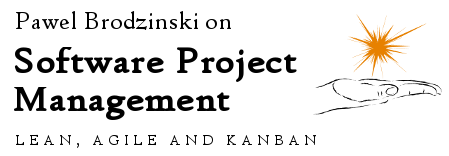So we had this project which was supposed to end by the end of July. Unfortunately a simple burnup chart, which we used to track progress, seemed rather grim – it was consistently showing very beginning of September as a completion date. A month late.
Suddenly, one day it started looking almost perfectly – end of July! Yay!
Wait, wait, wait. What? I mean, what the hell happened on a single day that we suddenly recovered from a month-long slip? Something stinks here.
After a while of digging we came up with the answer. Actually team invested some time to re-estimate all the work, including the work which was already done. Now, how the heck does it affect burnup chart?
It seems the chart on the y axis, where the work items were shown, had a sum of estimates and not just a number of tasks. It means that changing estimates in retrospect affects the scope and percent complete of the project. It actually means that such changes can affect predicted completion date as well.
This is called creative accounting and some people went to jail because of that, you know.
My first question is whether such re-estimation changes real status of a project in terms of how much functionality is ready, what is done, how many bugs are fixed or lines of code written or any other creative, crazy or dumb measure you can come up with to say how much work has been done. Or does it change how much more work is there to be done?
No! Double no, actually. It’s just a trick to tell us we aren’t screwed up that much. Actually, I accept the fact that we might have been OK in the first place and the chart was wrong. That would be awesome. But fixing the chart in such way, one, doesn’t change the status of work in any way and, two, just covers the real issue so it is harder to address it.
What is the real issue then? Well, there are a couple of them. First, using time-based estimates to show how much work is to be done is asking for troubles. Unless you are a freaking magician and you can make your estimates right 5 months before you even start working on the task, that is. If you’re just a plain human, like me, and you assume your estimates are wrong using them as a basis for tracing project progress seems sort of dumb to me.
It would be much better to count features or, if they vary much in size, count weight of features. Say S size is 3 times smaller than M and this is 3 times smaller than L or something like this. By the way, as you gather historical data you can pretty much fix these factors learning from past facts.
Second, even if you decided to go with estimates to judge how much work is to be done, what makes you thinking that fixing estimates in retrospect pushes you forward for an inch in terms of the next project you’re going to run? Do you expect to know exactly, in advance how much time will take you to build features in future projects? Because this kind of knowledge you’re applying now to “fix” your estimates in current project.
I would rather prefer a discussion on how to judge the scope better at the beginning of projects because this is going to be your benchmark. In this case precise estimates are almost useless. I will likely be pretty close in terms of telling how many features we have to build. It’s going to be trickier to say which of them will be small, medium or large. But I refuse to guess how many freaking hours each and every feature will take to build because such effort is utterly futile. It just so happens that I’ve forgotten to take my damn crystal ball with me, so sorry, that’s not going to work.
In this case estimation brings us to a trap. Knowing exactly how much time each work item has taken it is easy to track the progress in retrospect. Average 8-year old child would be able to connect the dots. However, unless you’re a bloody superhero and you’re going to have such data at the beginning of your next project don’t treat it as viable method of tracking progress.
Use any data that will be available in high quality at the beginning of a project. Number of features, maybe sized in some way if your team have some experience in sizing and you understand variability of work.
Anyway, whatever you do, just don’t change the benchmark in retrospect as it’s going to mess your data and cover a real problem, which is that you should improve the way you set the benchmark in the first place.
By the way: if you happen to work on time and material basis you can perfectly ignore the whole post, you lucky bastard. Actually, I doubt you even reached to this point of the post anyways.


 Subscribe RSS feed
Subscribe RSS feed Follow on Twitter
Follow on Twitter Subscribe by email
Subscribe by email



3 comments… add one
Very interesting (and funny) post. I especially liked your line about “your crystal ball”!
@Pawel, in my case you were wrong with the last sentence – sometimes I read posts backwards -, but right with the rest of the post ;-)
Love it! Thanks for the food for thought and a morning laugh, Pawel.
Greetings!